I can only guess what happened, but the eggs were there last night (night of the 12th) and were still there the morning of the 13th. So I went down around lights out tonight on 11-13 to pull the tile..and the eggs are gone. No larvae anywhere, which would suggest the hatch happened much earlier in the day. I’m starting to wonder – are my Lightning Maroons “day hatching”? It would seem to make sense and explain some of the “weird” hatches I’ve had and missed in the past.
- About The Lightning Project
- Inventory of F1 PNG Lightning and White Stripe Maroon Clownfish
- F1 PNG Lightning Maroon Clownfish, BZLM1
- F1 PNG Lightning Maroon Clownfish, BZLM2
- F1 PNG Lightning Maroon Clownfish, FW1
- F1 PNG Lightning Maroon Clownfish, LM10
- F1 PNG Lightning Maroon Clownfish, LM11
- F1 PNG Lightning Maroon Clownfish, LM12
- F1 PNG Lightning Maroon Clownfish, LM13
- F1 PNG Lightning Maroon Clownfish, LM14
- F1 PNG Lightning Maroon Clownfish, LM15
- F1 PNG Lightning Maroon Clownfish, LM16
- F1 PNG Lightning Maroon Clownfish, LM17
- F1 PNG Lightning Maroon Clownfish, LM18
- F1 PNG Lightning Maroon Clownfish, LM19
- F1 PNG Lightning Maroon Clownfish, LM20
- F1 PNG Lightning Maroon Clownfish, LM3
- F1 PNG Lightning Maroon Clownfish, LM4
- F1 PNG Lightning Maroon Clownfish, LM5
- F1 PNG Lightning Maroon Clownfish, LM6
- F1 PNG Lightning Maroon Clownfish, LM7
- F1 PNG Lightning Maroon Clownfish, LM8
- F1 PNG Lightning Maroon Clownfish, LM9
- F1 PNG Lightning Maroon Clownfish, MD1
- F1 PNG Lightning Maroon Clownfish, MWP3
- F1 PNG Lightning Maroon Clownfish, WS17
- F1 PNG Lightning Maroon, EC1
- F1 PNG Lightning Maroon, GL1
- F1 PNG White Stripe Maroon Clownfish, BZWS1
- F1 PNG White Stripe Maroon Clownfish, BZWS2
- F1 PNG White Stripe Maroon Clownfish, BZWS3
- F1 PNG White Stripe Maroon Clownfish, WS10
- F1 PNG White Stripe Maroon Clownfish, WS11
- F1 PNG White Stripe Maroon Clownfish, WS12
- F1 PNG White Stripe Maroon Clownfish, WS13
- F1 PNG White Stripe Maroon Clownfish, WS14
- F1 PNG White Stripe Maroon Clownfish, WS15
- F1 PNG White Stripe Maroon Clownfish, WS16
- F1 PNG White Stripe Maroon Clownfish, WS4
- F1 PNG White Stripe Maroon Clownfish, WS5
- F1 PNG White Stripe Maroon Clownfish, WS6
- F1 PNG White Stripe Maroon Clownfish, WS7
- F1 PNG White Stripe Maroon Clownfish, WS8
- F1 PNG White Stripe Maroon Clownfish, WS9
- F1 PNG White Stripe Maroon, EC2
- F1 PNG White Stripe Maroon, FW2
- F1 PNG White Stripe Maroon, GL2
- F1 PNG White Stripe Maroon, MD2
- Lightning Breeding Directive
- Lightning Maroon Clownfish Links
- Home
- About The Lightning Project
- Inventory of F1 PNG Lightning and White Stripe Maroon Clownfish
- F1 PNG Lightning Maroon Clownfish, BZLM1
- F1 PNG Lightning Maroon Clownfish, BZLM2
- F1 PNG Lightning Maroon Clownfish, FW1
- F1 PNG Lightning Maroon Clownfish, LM10
- F1 PNG Lightning Maroon Clownfish, LM11
- F1 PNG Lightning Maroon Clownfish, LM12
- F1 PNG Lightning Maroon Clownfish, LM13
- F1 PNG Lightning Maroon Clownfish, LM14
- F1 PNG Lightning Maroon Clownfish, LM15
- F1 PNG Lightning Maroon Clownfish, LM16
- F1 PNG Lightning Maroon Clownfish, LM17
- F1 PNG Lightning Maroon Clownfish, LM18
- F1 PNG Lightning Maroon Clownfish, LM19
- F1 PNG Lightning Maroon Clownfish, LM20
- F1 PNG Lightning Maroon Clownfish, LM3
- F1 PNG Lightning Maroon Clownfish, LM4
- F1 PNG Lightning Maroon Clownfish, LM5
- F1 PNG Lightning Maroon Clownfish, LM6
- F1 PNG Lightning Maroon Clownfish, LM7
- F1 PNG Lightning Maroon Clownfish, LM8
- F1 PNG Lightning Maroon Clownfish, LM9
- F1 PNG Lightning Maroon Clownfish, MD1
- F1 PNG Lightning Maroon Clownfish, MWP3
- F1 PNG Lightning Maroon Clownfish, WS17
- F1 PNG Lightning Maroon, EC1
- F1 PNG Lightning Maroon, GL1
- F1 PNG White Stripe Maroon Clownfish, BZWS1
- F1 PNG White Stripe Maroon Clownfish, BZWS2
- F1 PNG White Stripe Maroon Clownfish, BZWS3
- F1 PNG White Stripe Maroon Clownfish, WS10
- F1 PNG White Stripe Maroon Clownfish, WS11
- F1 PNG White Stripe Maroon Clownfish, WS12
- F1 PNG White Stripe Maroon Clownfish, WS13
- F1 PNG White Stripe Maroon Clownfish, WS14
- F1 PNG White Stripe Maroon Clownfish, WS15
- F1 PNG White Stripe Maroon Clownfish, WS16
- F1 PNG White Stripe Maroon Clownfish, WS4
- F1 PNG White Stripe Maroon Clownfish, WS5
- F1 PNG White Stripe Maroon Clownfish, WS6
- F1 PNG White Stripe Maroon Clownfish, WS7
- F1 PNG White Stripe Maroon Clownfish, WS8
- F1 PNG White Stripe Maroon Clownfish, WS9
- F1 PNG White Stripe Maroon, EC2
- F1 PNG White Stripe Maroon, FW2
- F1 PNG White Stripe Maroon, GL2
- F1 PNG White Stripe Maroon, MD2
- Lightning Breeding Directive
- Lightning Maroon Clownfish Links
First headstripe has been observed in a baby from Spawn #15. That is all….
Back on track it would seem…Spawn #14 appears to have completed metamorphosis. Despite good care, and seemingly good success, I can’t estimate more than 25-30 offspring.
Spawn #15 didn’t hatch as planned…only 2 babies the first night. Small hatch the next night, and possibly more the following night. Hard to tell how many larvae there are at this point, but they seem to be doing well so far. So potentially this was spread over 3 nights? Sheesh!
The last news, today, 11/6/2013, the pair put down Spawn #16.
Per my last post, the start of the week saw the spawning of the 15th batch, although I wasn’t around to see it. So I’m having to guess on the spawn date. I *thought* about pulling the eggs on Saturday night; this would have been 6 days (144 hours) post spawn, had they been laid on Monday.
I looked hard at the eggs, and decided they just didn’t look “silvery” enough for me to pull them. So I wanted 24 hours, knowing that in the past delaying when I thought things might be ready had caused the loss of a batch. However, this time the wait paid off…there were still the same number of eggs tonight, Sunday. So we are now either 144 housr, or 170 hours post spawn. Eggs were pulled and cleaned with roughly 3ML H2O2 (hydrogen peroxide) in a 1/2 gallon specimen container for 12+ minutes, and then into the BRT for hatching (the 10 gallon still has the near metamorphosis larvae from Spawn #14). I saw one baby hatch IN the H2O2 dip, so it’s very possible that I gut-timed this one right. Plenty of rotifers on hand, this could be a good run.
Was gone Monday and Tuesday…came back Tuesday night and discovered a BIG nest of Lighting Maroon Clownfish eggs…so we now have Spawn #15. Was it laid on 10/28/2013, or 10/29/2013? Not sure.
Spawn #14 is doing well, no shortage of rotifers this time, lots of silver bellies. I’m going to estimate that we had a couple hundred hatch (it was a small nest) and I’m guessing there are maybe 50 larvae in the 10 gallon tank at this point in time.
Tonight is the anticipated hatch night for spawn #14. It’s a smaller clutch…probably only a few hundred eggs to hatch, and it might have partially hatched earlier in the day or even last night. I set them up in the 10 gallon tank with blacked out sides, using 50% new water and 50% broodstock water. The eggs were sanitized with hydrogen peroxide at a rate of 3 ml / 0.5 gallon for 10 minutes, after which they were removed and placed in the tank for hatching. Lights on the broodstock system currently go out at 11:30 PM, but the room doesn’t reach its darkest point until 2 AM.
On an interesting side note, I may have discovered a contributing factor, if not the outright cuplrit, of the loss of all juveniles in spawn #12. It turns out that the Ehiem heater in the tank was no longer sealed…I noticed it wasn’t working when I sanitized and cleaned the tank earlier this evening, and upon closer inspection there was moisture inside and the coils showed white discoloration (reaction with saltwater presumably). Did this have an negative impact on the babies? Possibly…at minimum it cold explain why metamorphosis appeared to take so long…the tank may have been running cooler (eg. 74-76) than I had wanted, and that delayed meta could explain why the babies failed to survive post meta. Or not; it’s only one of many possible factors at play here.
So the tank has a new heater, and hopefully we get a good hatch tonight.
I finally go to shot some photos last week (October 14th), and among them are updates of the holdback pair. I’ve also updated the “Lightning Maroon Pattern Progression” post to show how it continues to evolve. Here’s the latest:
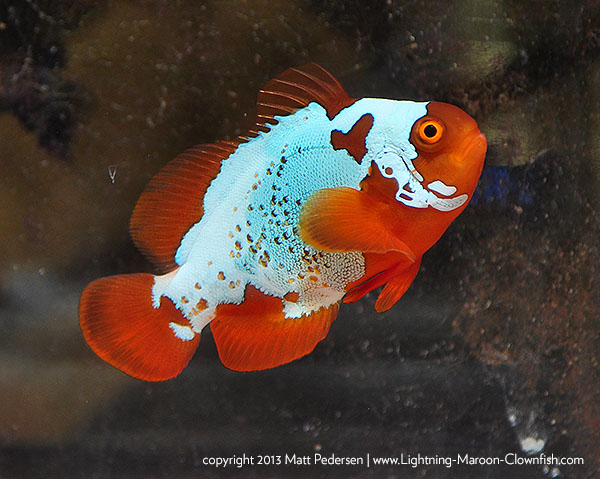

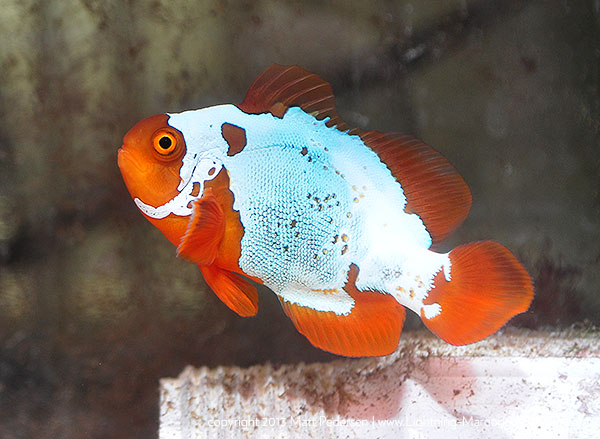
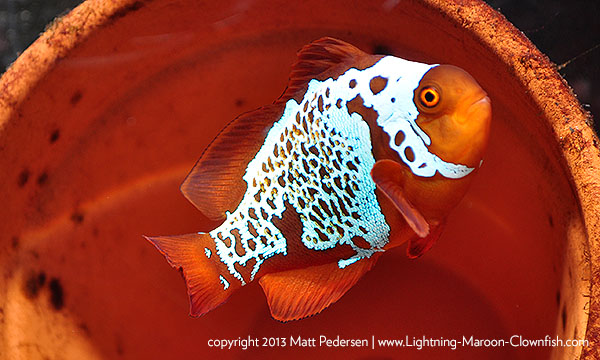

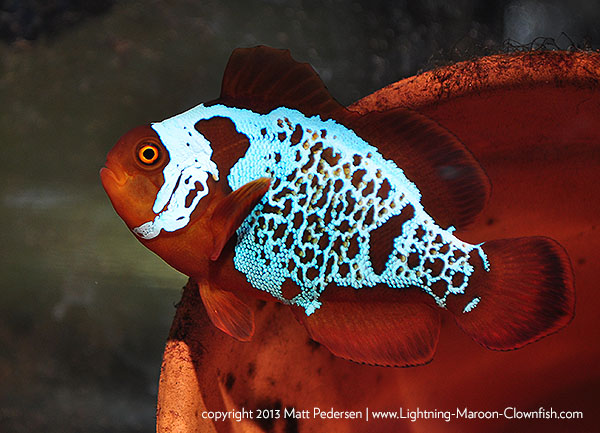

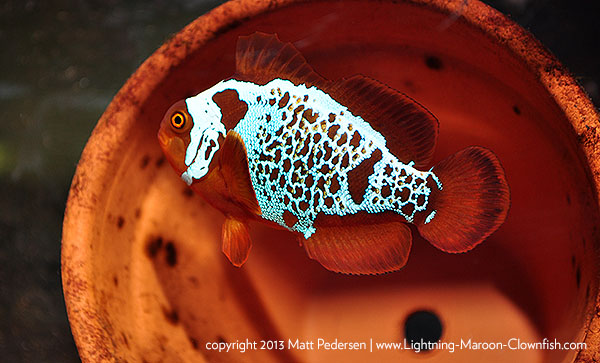
So I get yet another chance. The change in photoperiod set the fish off for a few weeks, but last Friday, October 18th, the 14th spawn was discovered.
An update on Spawn #13 – turns out I was wrong – once again, for the third time this year, there is a LONE survivor. And once again, as luck would have it, that lone survivor is a Lightning and not a white stripe.
This will be very short – I’ve just been swamped with freelance projects and endless deadlines and well, there’s just nothing good to report on the latest runs.
Spawn #12 did very well right up until metamorphosis. Immediately after metamorphosis, every larvae would die. I don’t know if it’s the different brine shrimp eggs I’m using (or even the fact that I’m using brine shrimp vs. not). It could also have been that I didn’t rear these with 24/7 lighting, but instead let them run on the regular photoperiod for the rack of tanks they were in. Water quality remained spot on and the fish were well taken care of. Thus ends Spawn #12. Probably changed too many variables all at once, but at least I may be onto something regarding getting good hatches for these eggs.
Spawn #13 never did produce much larvae, wound up hatching out over 3 nights. I found myself somewhat depleted on rotifers with this batch coming so quickly on the heels of spawn #12, so this batch really never stood a chance. I augmented from day one with Otohime A, introduced brine shrimp as early as was reasonable, but found no larvae made it to settlement.
Unfortunately I may have put the pair off spawning for a little bit (might not be a bad thing while I regroup). The lights on their system had been going off incredibly late in the night (eg. 3 AM) so I shifted the photoperiod. No spawns have come following this, which isn’t really a surprise. I’ll be curious to see how far back this pushes them.
Meanwhile, as I just posted on Facebook, I have more Fire Clowns (Amphiprion ephippium) than I know what to do with. Figures…
So I pulled spawn #13 tonight…1 AM on 9-30-2013….since #13 was spawned on 9/24/2013, I really should have pulled on the night of 9/30/2013…which would be Monday night, not the wee-early morning hours of Monday as I type this.
What will this do? Well, my other scatterbrained move was to once again apply a hydrogen peroxide (H2O2) bath…roughly 7.5 ML to 0.5 gallons…which is fine…’cept I ran it for 25 minutes instead of 15. The eggs outwardly looked fine, but did I just kill them? I hope not, and probably not.
Given that the last clutch was fine following treatment to hold for a day in artificial incubation, this gives me hope that if these are due to hatch in the next 24 hours, it will be just fine. What I’m going to do now however, is add H2O2 at a low level (roughly 1 ML per gallon) to help keep the BRT I placed them into relatively clean (1 ML per gallon is a standard rate for incubation of Pterophyllum scalare, FW Angelfish, eggs…when dosed every 12-24 hours). This should cause no harm to the eggs but should also keep any pathogenic bacterial and such at bay.
– UPDATE –
So….I’m adding drops of H2O2 to the water…I make it to 80 drops, roughly 4 ML and that’s when I noticed two newly hatched larvae swimming around the BRT. So I stopped adding H2O2 and turned the light off…are these fish really going to hatch in 5 days? 2 DID.
I’m guessing it’s going to be a full and strong hatch Monday Night / Tuesday AM, provided I didn’t screw things up.
Recent Comments